- Administrator
- Albums and Singles
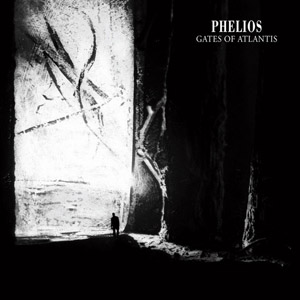 With Gates of Atlantis, Phelios (the solo project of Martin Stürtzer) has created a soundtrack in search of a film. It has a distinctly cinematic tone and structure to it, and even follows a loose narrative structure. However, there is far more than incidental sounds and music cues here, and it simply is too complex and varied to function with any other media.
With Gates of Atlantis, Phelios (the solo project of Martin Stürtzer) has created a soundtrack in search of a film. It has a distinctly cinematic tone and structure to it, and even follows a loose narrative structure. However, there is far more than incidental sounds and music cues here, and it simply is too complex and varied to function with any other media.
The opening title piece does exemplify this film-like structure right off the bat.Liberal applications of reverb and plucked synth strings set the stage before oppressive, dramatic crashes herald the arrival of monolithic kettle drums and intense dramatic flair.Intentional or not, it makes for perfect opening title credit music in its sound and bombast.Similarly, the closing "Ascension" both exemplifies its title and an uplifting ending to an apocalyptic narrative.Lighter synths abound, and when darker moments show up they are quickly battled away.
Between these two exceptional mood-setting moments, there exists a combination of both dynamic oriented grandiose compositions and more restrained, moody ones that keep things flowing for the album’s duration."Spiritual Possession" takes the connotations of its title literally, beginning with what sounds like a distant open door banging from the wind(or other forces) and bleak ambience.Things soon come to a head, with banging ritualistic percussion and what almost sounds like a fuzzed laden guitar squall that comes to a climax, and then ends peacefully.
Other moments are scaled back and understated."Temple of Yith" is all murky synthesizers and bass heavy rumbles that are the very definition of dark.A slow progression of noise and distortion comes and goes, but never does it become too aggressive. "New Stellar Age" is cut from a similar cloth in both its sound and mood.Again keeping the drums away, it opens in a subtler, haunting way as the surging keyboards build tension in a slow burn development.
Phelios may be one of many in the nebulous subgenres of dark ambient and death industrial, but his guile at composition puts him head and shoulders past most of his contemporaries.Not too many albums manage to capture such intense moods and conjure such powerful imagery based upon its sound alone (even though the packaging is rather Spartan, it has its own movie-like presentation).Gates of Atlantis is clearly a high water mark for the current state of the genre.
samples:
 
Read More
- Administrator
- Albums and Singles
 Robert Piotrowicz's LP from earlier this year, When Snakeboy is Dying, found the Polish composer stepping out of his comfort zone and working with a variety of traditional instruments with exceptional results. Lincoln Sea, however, sees him going back to his modular synthesizer array that has appeared on so many of his records. But rather than the chaos and noise that previous work was based, the sense of structure and composition here is significantly deeper and manages to touch upon rock and orchestral approaches.
Robert Piotrowicz's LP from earlier this year, When Snakeboy is Dying, found the Polish composer stepping out of his comfort zone and working with a variety of traditional instruments with exceptional results. Lincoln Sea, however, sees him going back to his modular synthesizer array that has appeared on so many of his records. But rather than the chaos and noise that previous work was based, the sense of structure and composition here is significantly deeper and manages to touch upon rock and orchestral approaches.
Piotrowicz's return to the world of oscillators and patch cables is obvious the second the first side begins with its sustained, just slightly off kilter tones and electronics that lean more into the upper end of the sonic spectrum.Even though at first the sound seems static, ever so subtle variations are present, as are some understated low frequency undertones.Soon it begins to change and evolve:multilayered sounds build upon each other into a stuttering, disjointed mass.
As it builds in intensity and seems to teeter into dissonance, a churning mass of carefully structured, organized sound rises up and then slows everything down with a more moody, disconnected sensibility to it. As the piece reassembles itself from sharp shards of electronic squall, a rhythmic bass line and pulse like a kick drum become prominent.The conclusion sees these rhythmic elements mixing with the intense electronics to sound like an alien take on hard rock structures, and approximates it quite well.
The second half of the album is slower, but more erratic.Frosty waves of electronics rise and fall and, while not exactly harsh, are uncomfortable with their slightly detuned sound.Aggressive bursts of oscillator add to this instability until things drift into more depressive, reserved territories.The synths become elongated and stretched into almost string-like passages, and with the dramatic surges and hits that arrive it sounds like a full synthetic orchestra being expertly conducted.
While conceptually Piotrowicz excels in his recontextualization of stereotypical modular synthesizer sounds, Lincoln Sea is an album that is riddled with unique and diverse sounds and effects.The two-part composition manages to take a multitude of directions as it builds to these stylistic crescendos, and the full package makes for another brilliant release in his ever growing discography.
samples:
 
Read More
- Administrator
- Albums and Singles
 A side project of members of Blessure Grave, Soft Kill does bear a resemblance, but one that focuses less on the folk tinged sound of that band and instead emphasizes the more post-punk elements. In some ways, Circle of Trees is a step backwards from their debut An Open Door: The live drums are replaced by a rigid machine and the overall production seems a bit more sparse, but it also gives the record a distinct sound, and along with it a few more uptempo moments than others in their catalog.
A side project of members of Blessure Grave, Soft Kill does bear a resemblance, but one that focuses less on the folk tinged sound of that band and instead emphasizes the more post-punk elements. In some ways, Circle of Trees is a step backwards from their debut An Open Door: The live drums are replaced by a rigid machine and the overall production seems a bit more sparse, but it also gives the record a distinct sound, and along with it a few more uptempo moments than others in their catalog.
Electric Voice, Handmade Birds
For the most part, all of the SK releases I have heard could have been recorded in 1981 and I would not know the difference, and I mean that in the most complimentary way.The dense, yet sharp production that bakes everything in tasteful reverb and gives each drum hit a razor sharp punch feels spiritually derived from Martin Hannett's classic productions in a beautiful way way.
Unlike other artists who are revisiting of this era of music, there is not the same desperate clinging to intense minimalism that all the various "-wave" subgenres are so enmeshed in.Like the best post-punk records, there is a definite sparseness to be heard, but here it works perfectly, like the stiff rhythm and serpentine guitar of "Lost" that obscure the distant, monotone vocals.
The synth heavy "Untitled," complete with electronic drums and theatrical vocals, comes across like Movement-era New Order with a more histrionic singer.Similarly, the intentionally stiff machines of "Vacant Home" definitely sound more 1980s than most of the material on this album, but in a beautifully endearing way, and the song manages to build in intensity as it goes on.
The most drastic variations on here are "Circle of Trees" and "Nine Years," both of which feature uncharacteristically jangly acoustic guitar sounds amidst the other instrumentation.Both because of this and an overall different approach to the songwriting, the result a clearly more up-tempo and lighter feel here, in a way that fits wonderfully.

The album was preceded chronically with a 7" on Handmade Birds that acts nicely as a bridge between the more guitar focused An Open Door and the keyboard heavy Circle of Trees."Current" focuses on a chiming, simple but effective guitar melodies, textural synths, and live drumming in place of a machine that straddles the two full length releases well.
On the flip side, "Seven Hundred" is another faster paced song, but with an appropriate amount of bleakness still present.Slower to develop, but richer because of the extra time, a rudimentary analog synth and echoing guitar is propelled along with a slowly rising rhythm that eventually locks in to a rapid pace. With the pacing and variation of Head on the Door-era Cure but the stripped down instrumentation and mood of Joy Division circa Unknown Pleasures, it is a perfect combination.
It is always hard to evaluate music that is so obviously a tribute to a specific era and genre, but Soft Kill manage to lock on to the timeless elements that formed the foundation of the best post punk records.Like early Factory releases and the proto-goth standard bearers of the early 1980s, it does not sound so specifically rooted in a certain time period as it could have.Someone with no knowledge of SK's influences could hear these records and place them accurately as being recorded within the past few years, but those with a deeper background will surely feel the appropriate tinges of nostalgia.
samples:
 
Read More
- Administrator
- Albums and Singles
 Staalplaat's latest pair of excavations from Muslimgauze's supernaturally bottomless vault is a bit of a surprise, as these two albums contain some of the best material to surface from the departed Bryn Jones in a very long time.  While a good portion of Tandoor Dog has admittedly appeared before, it was only as part of an extremely limited 4LP set that virtually no one has, while Izlamic Songs is an entirely unreleased, fully formed, and coherent album.  To my ears, Izlamic Songs is probably the better of the two (it has higher peaks, at least), but both intermittently capture Jones at the peak of his aberrant and bludgeoningly percussive dub genius.
Staalplaat's latest pair of excavations from Muslimgauze's supernaturally bottomless vault is a bit of a surprise, as these two albums contain some of the best material to surface from the departed Bryn Jones in a very long time.  While a good portion of Tandoor Dog has admittedly appeared before, it was only as part of an extremely limited 4LP set that virtually no one has, while Izlamic Songs is an entirely unreleased, fully formed, and coherent album.  To my ears, Izlamic Songs is probably the better of the two (it has higher peaks, at least), but both intermittently capture Jones at the peak of his aberrant and bludgeoningly percussive dub genius.
Izlamic Songs opens in spectacular, "instant classic" fashion with "I Will Sing Until My Land Is Free," unfolding a vocal  lengthy vocal sample over a very heavy percussion and tambourine loop augmented with ominous buzzing swells and deep bass rumble.  The four other "real" songs left in its wake do not have quite the same bulldozing intensity, lamentably, but the basic building blocks remain the same: I think this album could reasonably characterized as atypically "collage-y" and textural.  It is certainly a very rhythmic release ("Tourist Vice Hole" is built almost entire upon clattering hand drums, for example), yet the emphasis seems to be much more on tweaking vocal and string loops rather than on the groove.  In fact, the sole brazenly groove-y addition seems to be that each song features a simple bass loop that is so deep and overloaded that the actual notes being played are meaningless–the bass exists almost entirely as a forceful physical presence.
Of course, the fact that Izlamic Songs is so sparse on conventional music does not mean that Jones was lazy.  Rather, Jones channeled his formidable energy into the studio, turning his well-chosen loops into vibrant pulsing soundscapes that unpredictably pan, stutter, drop-out, and echo.  Bryn also seems to have been very fixated on reversing samples during this period, as surreal backwards and possibly pitch-shifted loops play dominant roles in a number of pieces.  In fact, it seems like Jones either set out to make an album of hallucinatory psychedelia that somehow derailed along the way or that he succeeded, but did it in a way that is distinctly his own.  I am leaning towards the latter, as the omnipresent clattering clip-clop of the tablas mingled with the mammoth buzzing bass created a heavy and appealing bed that allowed Bryn to be as experimental as wanted in all other respects.  Just in case that was not enough, however, Jones also included a surprisingly effective smattering of hooks throughout the album, the best of which is the twanging string snippet in "Sahara Head Dress" (a motif that also periodically stutters and reverses, in keeping with the surrounding music's obsessive themes).
The first five songs are just the prelude to a more substantial trip down the rabbit hole though: the album's final three songs are remixes of music by Systemwide and Jones drops just about every pretense of striving for song-craft or listenability.  Only the first one is particularly substantial (it is over 8 minutes long), but all are quite nakedly and aggressively experimental.  For most of its duration, "Systemwide Virus Abuse 1" plays like a dystopian future twist on the album's earlier aesthetic: a lazy beat unfolds beneath an all-consuming thick buzzing electro bass pulse that buries everything, yet constantly falls prey to glitch-like cut-outs and manglings.  Then it all abruptly turns into a drum loop accompanied by fluttering electronic chaos, vocal loops chopped into oblivion, and a lot of disorienting echo-abuse.  The remaining two bits of "Virus Abuse" offer up escalating craziness coupled with dramatically shortened running times, at times resembling a recording of an over-caffeinated tabla and candy-colored synth frenzy being eaten by a tape player, while at other times approximating "the sound of a drone crashing" (as Jones topically wrote on the tape almost 20 years ago).
I would not necessarily describe any of the remixes as "great," as they are all either too short or too baffling constructed to succeed as self-contained songs, but such an aggressively deranged ending is somehow exactly what the album needed.  I am not sure if it was Jones' idea or Staalplaat's, but I am a huge fan of the sequencing tactic of closing the album with a plunge into deep experimental waters–it makes for a much more strange and memorable effort and the impact of the coherent songs beforehand is not diluted by a series of very similar regurgitations (a typical Muslimgauze crime).  I have absolutely no idea how this album managed to languish in the vault for so long, given the steady flow of half-baked and redundant material that has already surfaced, but I very happy that it eventually found its way out.  Albums like this are why people are still excited about Muslimgauze.
 

Tandoor Dog, for its part, has a very interesting aesthetic that took me a little longer to warm to, as it is essentially a variation on the "hip-hop" Muslimgauze era (not my favorite time).  Fortunately, it happens to be a fairly weird and unhinged variation, which are traits that are always very much to my liking.  Opener "Aurum Franc Insense Ul Myrrh" sets the album's recurring themes in motion nicely: a laid-back breakbeat groove, an incredibly dense and insistent bassline, stuttering stops and starts, and swarming static-y and mangled samples.  Unlike some of the other extremely beat-driven material that has surfaced, it legitimately sounds like Bryn put some serious work into these pieces long after he had his grooves laid down, as the beats and samples are constantly, vibrantly morphing and changing in texture and dynamic.  Also, Jones' requisite Arab-world samples are atypically snarling and harshly manipulated.
For a while, the sole twist on the formula is that a few songs feature mid-tempo Arabic percussion grooves rather than midtempo breakbeat ones.  Within those narrow stylistic confines, however, Jones found a lot of appealing twists and hooks.  For example, "Under the Burka" sounds like Muslimgauze channeling early Aphex Twin, combining buzzing electro-bass and a queasily dissonant, see-sawing motif that mesmerizingly repeats obsessively.  Also, everything simply sounds great: the clattering drums often have a sharp clarity and Bryn went positively bass crazy, enhancing these songs with a thick, pulsing, neighborhood-rattling physicality.  If there are any Muslimgauze fans out there who just installed totally sick woofers in their Camaro, this is probably exactly what they have been waiting for.
As with Izlamic Songs, things take a sharp detour at the end of the album though, which also happens to be where Tandoor Dog starts to extend beyond the 8 songs originally included in 1997's Tandoori Dog box set.  The first divergence is not particularly promising, as "Damascus" is essentially a cannibalized and extended version of Dar Es Salaam's "El-Dar-El-Beida" that clocks in at a too-long 13:11.  However, the final two pieces ("Noor et Hussein Pt. 1 & Pt. 2") seem take that same raw material and reprise it in a slower, pitch-shifted way that is extremely effective.
Both pieces are relentlessly, punishingly obsessive in their repetition, but also extremely hypnotic.  Also, they are not at all boring (to me, at least), as Jones unpredictably disrupts their insistent throb with violent slashes and stutters of static and crackle.  Both resemble a menacingly inhuman locked groove that is jarringly deteriorating or being ripped apart by a wild animal.  It is entirely possible that I am the only one around that finds that particular aesthetic appealing, but I am thrilled that Staalplaat decided to include such a wildly indulgent and bizarre ending–such a gamble is vastly preferable to any possible alternatives that I can think of.  Also, it makes for a very strong  and focused ending to a surprisingly strong and focused album.
 
Read More
- Administrator
- Albums and Singles
A raw live recording from earlier this year, Chalaque's main man Nick Mitchell performs here with Eric Hardiman (Century Plants, Rambutan et. al.) on bass and Pascal Nichols on drums. Essentially a live on stage improvisation, the trio bounce off each other perfectly and manages to grasp that tenuous balance between experimentalism and pure unadulterated rock and roll.
Consisting of two side-long pieces that are each made up of numerous, interlocking improvisations, there definitely a roughness to this recording, which captures crowd noise and is occasionally a bit overloaded by the intensity of the sound. This is not overly surprising, given that it is based on a hand-held recorder in the venue, but it also gives a primal, intense edge to the music that helps far more than it hurts it.
The lead off of "Simple Mathematics" focuses on Mitchell's rapid, noodling solos that manage to just be the right kind of sloppy, as Hardiman's overdriven bass and Nichol’s sharp, ragged drums propels everything along rapidly. With its changing paces and shifting focuses, with the guitar going into sludgy, noise territory and the bass picking up the melodic slack, it does get a certain jam session vibe to it. Thankfully, the improvisations feel much more like early King Crimson than modern Phish.
On the flip side, things are a little looser and more experimental feeling as a whole. The overdriven bass and clattering drum solos that introduce "Toeing the Water of a Cinematic Absence" make this apparent right from the start. Eventually the rapid drums and basic, but powerful bass line come together and restrain the guitar somewhat, even with its wah-wah heavy leads threatening to go off on their own tangents. About a third of the way through the whole song seems to falls apart into a lumbering mass of ramshackle drums and feedbacking guitar. Slowly, but surely, the trio reshape this chaos into a powerful wall of hard driving psychedelic rock that would make Hawkwind jealous.
With its lo-fi recording and improvisational nature, Sounds From the Other Ideology has a clearly wild, chaotic quality to it that gives it a sense of immediacy and intensity. Never does it sound directionless or self indulgent, as can often happen in performances of this nature, it instead uses the sonic warts and technical limitations to its best advantage. When things get messy, it is glorious, but things never go to far out of hand, and the group always manages to reign things in brilliantly.
samples:
Read More
- Administrator
- Albums and Singles
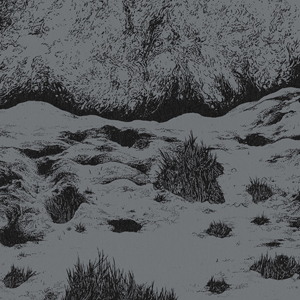 Two different artists who both work within the realms of psychedelic tinged minimalism share this split single that in a genre sense are very different from one another, but thematically and conceptually make an excellent pairing and compliment each other quite well.
Two different artists who both work within the realms of psychedelic tinged minimalism share this split single that in a genre sense are very different from one another, but thematically and conceptually make an excellent pairing and compliment each other quite well.
John Kolodij's High Aura'd supplies "Remain in Light," and while any specific references to the Talking Heads slipped right past me, the conceptual flow of the song matches the title well.Initially a wall of shifting rain like noises, it slowly enters the sunlight with a melodic tone to it, offset by a bit of looping, textural like static.However, extended sun exposure can damage, and as the piece wears on it concludes in a noisy, swirling vortex of what sounds like guitar noise and destruction.
On the flip side, Blood Bright Star, a relatively new solo project by Reuben Sawyer, goes right into a more straight forward krautrock sound.Heavy, tremolo laden guitar echoes and slithers about while propelled by a rock solid motorik rhythm on "Golden Blood, Part II."Even with these pieces put together, the result has a sort of blues swagger that gives it a unique edge and sound.
Both halves of this single clearly work in the realms of minimalism, but taking notably different approaches.Kolodij’s contribution does this via instrumentation, doing significant work with a sparse collection of tools, while Sawyer uses it as a compositional framework, building upon the signifiers of blues and rock to create a repetitive, but constantly evolving song.
Read More
- Administrator
- Albums and Singles
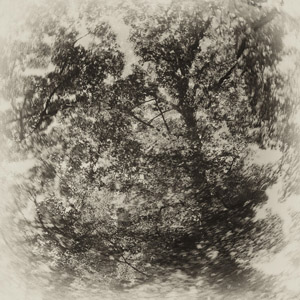 A Zelienople side project featuring Matt Christensen and Mike Weis, the latter also of Kwaidan, and Scott Tuma recorded the material that comprises this album originally for a CD-R in 2006 and have been rather quiet since. Reissued with a wider scope and presentation, the seven untitled pieces that make up this album are in league with their other projects, yet have a hazy, singular edge all their own.
A Zelienople side project featuring Matt Christensen and Mike Weis, the latter also of Kwaidan, and Scott Tuma recorded the material that comprises this album originally for a CD-R in 2006 and have been rather quiet since. Reissued with a wider scope and presentation, the seven untitled pieces that make up this album are in league with their other projects, yet have a hazy, singular edge all their own.
Awash in reverb, much of the instrumentation used on this LP is somewhat indistinct, aside from the focus many songs have on acoustic guitar that gives a certain folk feel to the music.The second song, for example, puts the focus on the instrument, casting the guitar notes amidst a sea of reverb and open, glorious space, occasionally drifting into a western-esque twang and sometimes meeting up with almost sounds like a sitar as a very different counterpoint.
The third piece continues the theme but reconstructs it into the most diverse, powerful song on the album.Dropping the overt guitar, the droning electronics and synth-like moments of what preceded it become the focus, and with the addition of infrequent, but prominent percussion, it takes on an intense, cinematic quality that builds and builds into its harsher, dissonant conclusion.
The beginning of the second side of the LP retreats from this grandiose conclusion, slowly spreading out as sparse and fragmented, with clinking noises and what sounds like a bass guitar leading off.While stripped back to the barest essentials, everything is obscured in an intentional, opium smoke haze of sound and mood.The sixth untitled piece goes even further back, leaving just the most basic of acoustic guitars and a bleak, dark bed of muddy ambience.
The second side is closed with another climactic piece, this time what sounds like strings (synthetic or natural) resonating in a cavernous expanse, with blurping synths popping up here and there as a more forceful outburst.Vocals are present, but buried and effected to lack any clear lyrical meaning.It is complex, but has a distant, organic feel, and the entire song seems to slowly drift apart as it concludes, like oil diffusing in an oceanic expanse.
Like its sepia tinged abstract cover art, this record from Good Stuff House is shrouded in a hazy, mysterious fog.Distant and obtuse, but with a warm, inviting nature, it is an enigma that begs to be solved, but is not the most simple thing to understand.
samples:
 
Read More
- Administrator
- Albums and Singles
 Jenny Hval takes a morbid pleasure in using her voice to provoke discomfort on her second full-length release. From the opening lyrics of the title track to the arcing croon of "The Seer," Innocence Is Kinky lives its title through a bravery bordering on refuge in audacity. It seems to be a defense based in false naïveté, where Hval's surrealistic persona adds a unique flourish to a collection of unabashedly smart and well constructed songs on gender and sexuality. As the record unfolds, this keen irreverence pays off. Innocence Is Kinky reveals itself as one of the better singer/songwriter albums of 2013, hiding a deeply powerful message under the false guise of shock.
Jenny Hval takes a morbid pleasure in using her voice to provoke discomfort on her second full-length release. From the opening lyrics of the title track to the arcing croon of "The Seer," Innocence Is Kinky lives its title through a bravery bordering on refuge in audacity. It seems to be a defense based in false naïveté, where Hval's surrealistic persona adds a unique flourish to a collection of unabashedly smart and well constructed songs on gender and sexuality. As the record unfolds, this keen irreverence pays off. Innocence Is Kinky reveals itself as one of the better singer/songwriter albums of 2013, hiding a deeply powerful message under the false guise of shock.
Jenny's voice throughout Innocence Is Kinky is mixed high, tactile and wet and percussive. I prefer it as such, because the balance of the album lies in its uncanny subversion of what might be expected for a female-driven vocal pop album. Hval excels in a brand of flippant, mellifluous, blink-and-you-miss-it vocal arcs and tweaks, exploring each crevice in the spaces she creates. It reminds me initially of traditional folk music, but there is also a jazzy complexity at work, a melodic savvy and faith in her instrument that excuses the occasional over-indulgences. Her lyrics are bluntly profane, a system of orifices and gasping non-metaphors; not just "having sex" but "fucking."
I find that the most glaring examples of Jenny's over-exuberance also make for the strongest songs. The title track opens the record with a disarming declaration of love for internet porn, but soon transforms into a surreal and powerful expression of sexual independence. "Mephisto In The Water" finds her protracting the song's bridge and repeating its last few words, tensely ascending in pitch until she goes flat, clamoring against her vocal nuances in a strenuous show of loss or need or something stranger. "Death Of The Author" drops off halfway into a clattering chorus of fuzz and percussion, Hval crying out an existential mantra: "Me by your eye/me by your hand/me by your mirror." "The Seer" closes out the record as a keenly transformative manifesto, a spiritual awakening of vowels and endlessly reverberating tonal quirks, layered over a dense religious drone.
On its own, the material backing Jenny Hval's singing is nothing remarkable, and pretty disconnected. It is a typical grab-bag of drone-influenced pop, with occasional rock passages and some experimentation with noise and feedback. On her sheer strength alone she elevates the quality of the album to something transfigured and new, though. Commanding unfettered confidence she sings on gender, sex, repression, Oedipal complexes, femininity and a loss of identity so viscerally so that the songs are not distinguished by their accompaniments but the topics and her unmatched ferocity in approaching them. I will return to it often, if only to glimpse a little gracious bit more of its depths.
Samples:
Read More
- Administrator
- Albums and Singles
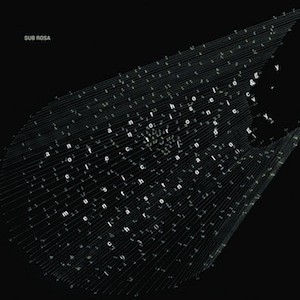 For its seventh and final volume, Sub Rosa’s mighty experimental music compilation has been expanded to a triple CD. At this point, I would have thought that all the good stuff would have been covered but label boss and Anthology curator Guy Marc Hinant has managed to uncover more startling curiosities from the last 150 years to make this series go out with a bang (and a drone and a blast of white hot feedback).
For its seventh and final volume, Sub Rosa’s mighty experimental music compilation has been expanded to a triple CD. At this point, I would have thought that all the good stuff would have been covered but label boss and Anthology curator Guy Marc Hinant has managed to uncover more startling curiosities from the last 150 years to make this series go out with a bang (and a drone and a blast of white hot feedback).
When the first volume of An Anthology of Noise & Electronic Music came out, I was just starting university and finding my way from mainstream metal and electronic music into the wilder world of music through groups like Einstürzende Neubauten and Throbbing Gristle. I noticed this compilation in Dublin's Road Records (unfortunately a thing of the past) and saw Neubauten was on the tracklist so I took a punt on it. It blew my mind and most of the material took me years to come around to. Fast forward to 2013 and I am still finding An Anthology of Noise & Electronic Music to be a challenge, even a slog at times. This has been the series’ strength in actually presenting music that represents a true avant garde sensibility (even if the avant garde it is documenting is largely six feet under at this point in time).
Like previous volumes, this seventh volume hopscotches around time and theme to create a baffling tapestry of recorded sound. Pieces from the 1950s like Henry Jacobs' "Sonata for Loudspeakers" and Bebe and Louis Barron’s "Bells of Atlantis" (which is stupendously good) represent the work of very enthusiastic amateurs (indeed the Barrons would go on to score the soundtrack for Forbidden Planet a few years later) whose pieces sit comfortably alongside "serious" academic works like Luciano Berio’s "Thema (Omaggio a Joyce)." Suddenly, we are dropped from this quaint world of tape experimentation into the future worlds of modern electronic music. Works by Benjamin Thigpen and Helmut Schäfer demonstrating how experimental music is continuing to develop, even if it lacks the same "shock of the new" as in former times.
Included as a footnote at the end of the first disc is the now legendary phonautograph recording by Édouard-Leon Scott de Martinville of a human voice singing "Au Claire de la Lune." Its place on this collection is at first strange, this is neither a piece of electronic music and Scott de Martinville was obviously trying to capture sound as oppose to corrupt it. Yet it is only through techniques developed through the exploration of electronics in relation to sound that is possible to hear this piece of history (it’s also not the most melodious things I have ever heard).
A sizeable portion of the compilation is given over to the electric guitar, the scourge of parents’ hearing the world over for decades. Alan Courtis and Justin Broadrick both demonstrate how the electric guitar is a perfect instrument for fooling around with in terms of bedroom setups and signal processing. Fausto Romitelli’s "Trash TV Trance," performed by Tom Pauwels, takes a different take on noisy guitar with its complex, frenetic playing simultaneously virtuoso and overwhelming. The cream of late '80s, early '90s indie guitar worship (namely Spacemen 3 and My Bloody Valentine) are also present in the form of E.A.R. whose line up for this recording is a dream team of Peter Kember, Kevin Shields, Kevin Martin, and Eddie Prévost. The guitars are not the focus here but are certainly integral to the piece as it unfolds slowly and beautifully through various psychedelic tones.
The pure noise end of the spectrum is also well catered for with a euphoric early piece by The New Blockaders; "Blockade is Resistance" purges the air like a holy fire and is confrontational even by today’s standards. More disturbing is Warong Rachapreecha’s "Shambles," which is just under a minute of a pig being slaughtered. Less distressing is "Skate" by The Rita where Sam McKinlay manages to combine the hypnotic sound of skateboarding with harsh noise. Taken together with similar works smattered throughout the series, any notion of noise being a homogenous wall of feedback is strongly contested. Even as someone who has spent a lot of time listening to this sort of music, the Anthology of Noise & Electronic Music has served to reignite my interests and reboot my auditory cortex.
What is surprising at the end of the series is not that Hinant has managed to miss out on seminal artists like Throbbing Gristle, Whitehouse, Keiji Haino, David Tudor, Coil, Nurse With Wound, Kraftwerk, Pierre Henry, Kurt Schwitters, Marcel Duchamp, Delia Derbyshire, etc. etc. but that their absence is only noticeable when you are writing a review for an online music magazine. While I am dismayed that there will be no future instalments in the series, I am still working my way through all the previous volumes to revisit and re-examine the artists included. This last volume contains as much, if not more, unfamiliar works as it does familiar which I imagine will mean an expensive few years of tracking more material down.
samples:
- Luciano Berio - Thema (Omaggio a Joyce)
- E.A.R. - Beyond the Pale
- GX Jupitter-Larsen/The Haters - Fuechen
 
Read More
- Administrator
- Albums and Singles
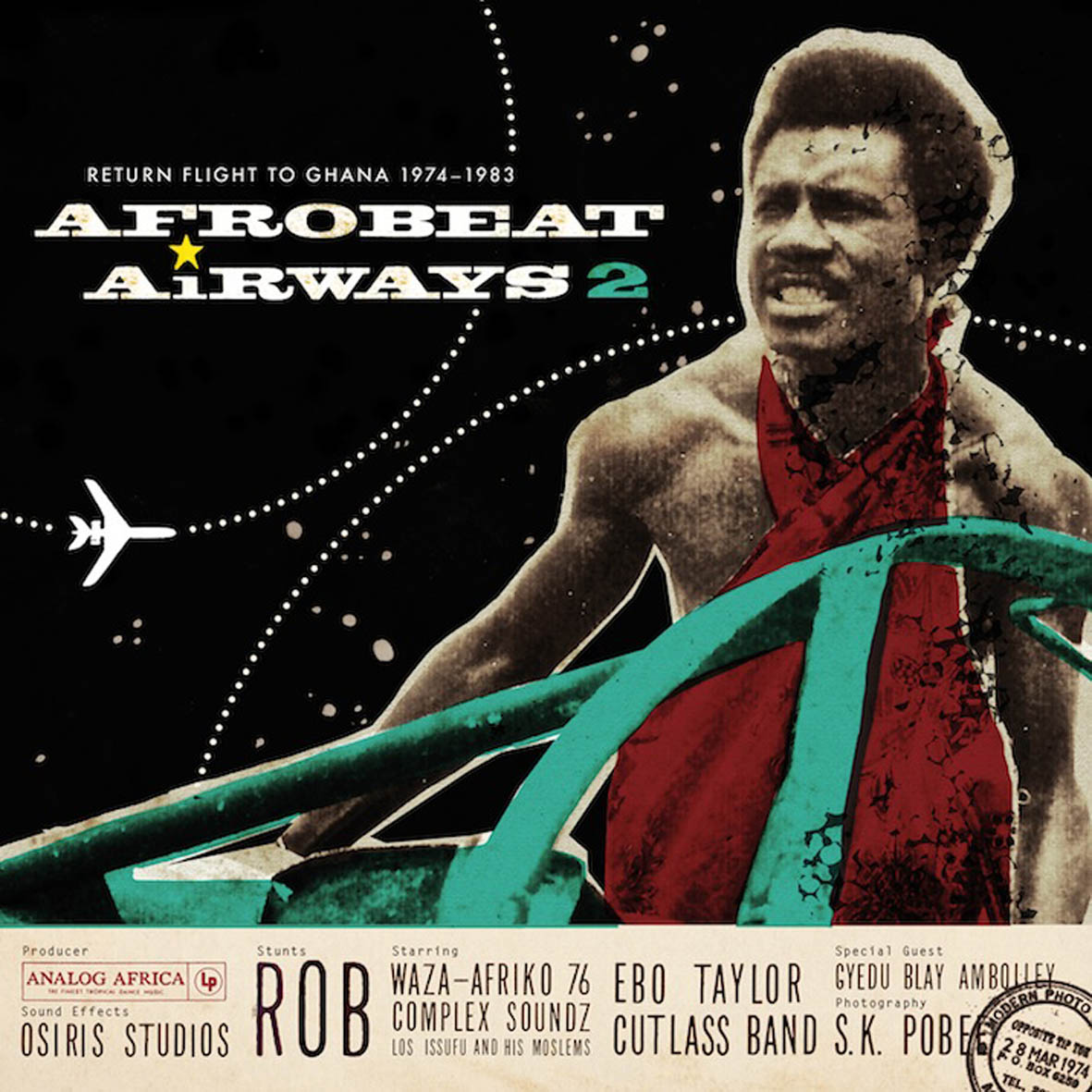
This sequel to 2010's fine Afro-Beat Airways delivers still more Fela-free gems from Ghana's golden age, which is (of course) is exactly what I wanted and expected.  While many of the featured artists (Vis-A-Vis, K. Frimpong, etc.) will already be quite familiar to anyone with even a casual interest in African music reissues, the material is uniformly solid and offers enough obscurities to keep things interesting.  Even the most jaded aficionados will enjoy Samy Redjeb's characteristically colorful and exhaustive liner notes though, as he has unearthed a slew of rare photos and tracked down some interesting interviews with a lot of people who probably never expected to be interviewed by an excited German in 2013.
By now, the "Analog Africa compilation" aesthetic is a very well-established formula, and Redjeb wisely does not mess with it for Afrobeat Airways 2.  Occasionally, Samy will surprise me with something completely amazing like last year's Diablos Del Ritmo, but most releases just offer up a generally likable batch of songs rescued from obscurity mingled with a handful of legitimately great ones that I wind up listening to in fairly heavy rotation for months (or years) afterward.  Nearly all of those gems this time around predictably come from the usual suspects, like Uppers International's stuttering, darkly funky "Aja Wondo" and K. Frimpong's lurching, understated "Abrabo" (a piece sans his Cubanos Fiestas that I have not heard anywhere else).  And, of course, the ever-reliable Rob delivers yet another predictably lascivious delight ("Loosen Up Yourself").  Also, while I was previously unfamiliar with Pierre Antoine (whose "Say Min Sy Soh" is probably the album's highlight), he is backed by the awesome Vis-A-Vis, which explains everything.  Actually, Vis-A-Vis are also the uncredited backing band for the K. Frimpong song, so they more or less steal the show on this compilation.
Music aside, what makes Analog Africa compilations so unique and special is their lavish and exhaustive liner notes and Afrobeat Airways 2 boasts some of Redjeb's best work, as Samy seems to have been in an uncharacteristically poetic and reflective mood.  For example, he summarizes the abandonment of horn sections for synthesizers, drum machines, MIDI, and computers thusly: "The harvest of this dispassion is three decades of sonic mediocrity."  He also tours the former site of one of the scene's hottest clubs (since converted to a church) and notes "I was shown around by a kind gentlemen who was trying to convince me that there were an infinite number of paths to accept Jesus as my personal savior. Little did he know that my 'saviors' had left the stage many years ago."  On a related note, it was morbidly fascinating to learn that the entire scene was essentially killed by a government-instituted curfew, a decision that more or less forced every relevant musician in Ghana to pack their bags and head elsewhere.
The real coup for this compilation, however, is that Redjeb was able to get access to the archives of Modern Photo, whose somewhat disinterested proprietor let him sort through boxes and boxes of forgotten negatives that had narrowly survived a flood.  Many of those photos are included in the booklet and some of them quite wonderful, particularly one of Fela Kuti exiting a plane with his entire female entourage, though I also enjoyed all of the Boogaloo competition shots.  Even the less spectacular aspects of the liner notes are endearing though–even though guitarist Sammy Cropper's interview yielded the usual litany of names, dates, and places, it was life-affirming that Redjeb went through the trouble to track down an aging school security guard to tell him that he is regarded as a guitar god and that people are excitedly trying to track down forgotten recordings that he made four decades ago (I am perhaps getting a bit sentimental in my old age).
Overall, this is a much better than average Analog Africa collection: it is not quite essential, but it should disappoint absolutely no one.  Aside from the songs mentioned above, there are quite a few other strong moments, particularly Waza-Afriko 76's "Gbei Kpaka Hife Sika."  Such a high success rate is surprising for an Afrobeat compilation, as the genre has historically been plagued by wild excess and indulgence–to Redjeb's credit, very little of that surfaces here, as most songs are under five minutes and few are even under three(!).  Even the few songs that I do not particularly like (Tony Sarfo's American funk pastiche and De Frank's repetitive, sing-songy "Waiting For My Baby") are appealing enough to avoid being dismissed as mere filler.  Of course, the music is only part of the picture in this case, which is why Analog Africa compilations are so great: Afrobeat Airways 2 is basically yet another important chapter in a lovingly assembled crash course in African culture and history taught by one singularly enthusiastic crate-digger.
 
 
Read More
- Administrator
- Albums and Singles
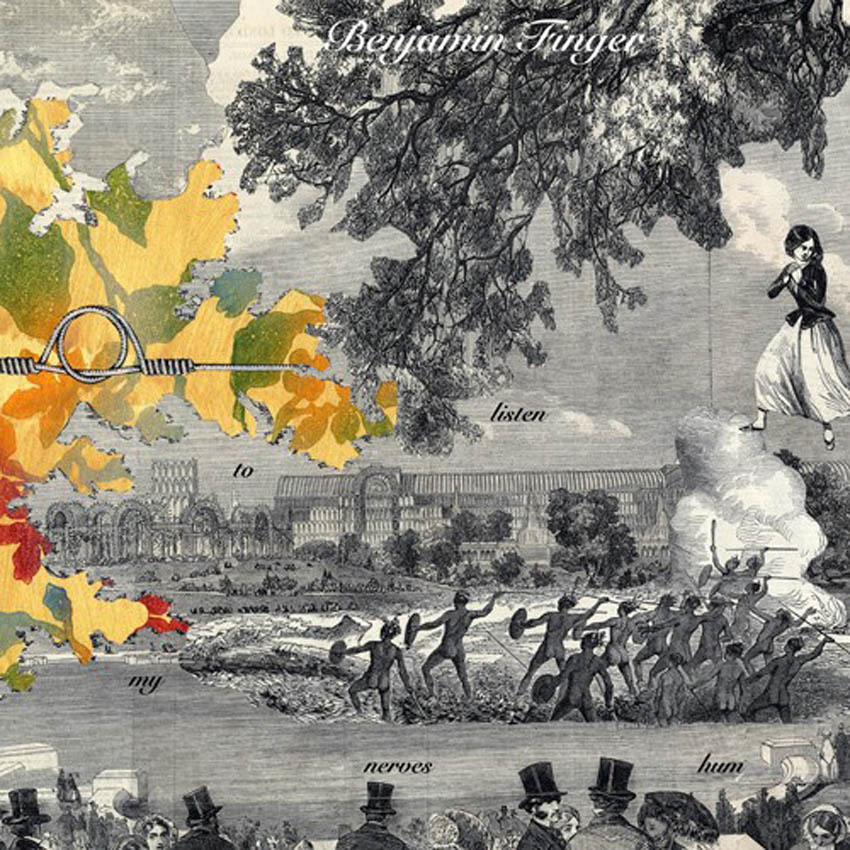 I have been casually following Benjamin Finger's career ever since being completely blindsided by his hallucinatory 2009 masterpiece Woods of Broccoli and I have found it quite perplexing to observe: Broccoli never got even a fraction of the acclaim it deserved and its beat-driven 2011 follow-up (For You, Sleepsleeper) seems to have completely disappeared without a trace.  In a perfect world, this latest effort would redress that inequity (Nerves is Finger's first release on a US label), but Benjamin's current aesthetic has taken quite a curious and challenging turn.
I have been casually following Benjamin Finger's career ever since being completely blindsided by his hallucinatory 2009 masterpiece Woods of Broccoli and I have found it quite perplexing to observe: Broccoli never got even a fraction of the acclaim it deserved and its beat-driven 2011 follow-up (For You, Sleepsleeper) seems to have completely disappeared without a trace.  In a perfect world, this latest effort would redress that inequity (Nerves is Finger's first release on a US label), but Benjamin's current aesthetic has taken quite a curious and challenging turn.
The most succinct and glib way to describe this album is this: Benjamin Finger just bought a piano and seems to be very excited about it.  However, the truth is a lot more complicated and puzzling than that, as Finger has always had a piano and he has employed it quite beautifully in the past as just one small part of his complex, multilayered arsenal.  With Listen To My Nerves Hum though, Benjamin has essentially jettisoned everything else from his palette except for some muted field recordings.  Also, on a deeper level, he seems to have additionally abandoned almost everything he knows about music: on Beneva vs Clark Nova's Sombunall, he showed he could craft great electronic pop songs, then on Woods of Broccoli, he demonstrated that he was even more adept at fragile, sublimely beautiful psychedelia.  With Nerves, he often sounds like an outsider artist trying to channel Erik Satie though real-time improvisations.
While that admittedly seems like a very self-defeating move, it is also a very daring and noble one: all artifice and processing has been stripped away to leave only music at its most naked and organic.  I doubt I ever would have given Nerves a second listen if I had not already been confident that Finger knew what he was doing, but there is definitely something here–it just takes some significant attention to appreciate it, as the album's quiet, unique beauty gradually revealed itself to me more and more with repeat listens.
Most of the best parts occur when well-chosen field recordings unexpectedly make their way into the foreground, like they do in album highlight "Ãno Nuevo Acid Crackers," where the melancholy plinking piano motif is gradually forced to share the stage with the celebratory sounds of a fireworks display.  Most of the time, however, the field recordings are used in much more subtle fashion, lending just a hint of cinematic otherness to Finger's playing (like the footsteps, echoing voices, and crackling French radio broadcast beneath "Das Paris Des Second Empire Benjamin").  Also, the sound of Benjamin's piano is in itself somewhat mesmerizing, as it seems close mic'd in a way that renders every little oscillation and nuance of decay audible.
All of that makes Listen To My Nerves Hum an extremely difficult album to formulate a clear opinion on.  As a listener, I found the album to be a bit exasperatingly one-dimensional and simplistic, as it feels like a series of sketch-like, lo-fi improvisations.  My frustration was amplified by the fact that several individual pieces were quite good and would have been much more striking and emotionally resonant if they had been transitioned to in a more effective and dynamically/texturally varied way–an entire album of monochromatic, minimalist piano tinkling invariably makes my ears very sleepy.  However, as a Benjamin Finger fan, this album is kind of exciting: it is ambitiously uncharacteristic and unexpected, deliciously cryptic, and leaves me with absolutely no idea where he might go next.  Also, the music itself is just one facet of the release-if I had been one of the 70 people to get the limited edition CD version, I would probably be hailing Nerves as an unqualified masterpiece, as it might possibly have the coolest packaging that I have ever seen (it folds out into a strange extinct bird mobile made from antique piano innards).  Which, I suppose, ultimately makes Listen To My Nerves Hum a great installation rather than just a likable, but flawed, album.
(Note: This is a review of the marginally less cool-looking vinyl version, as the hopelessly sold-out "bird mobile" version includes five additional songs)
 
Read More